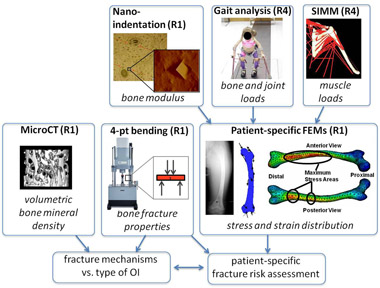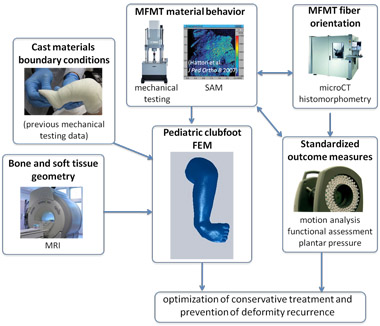Research Activities
Nano- and Microstructural Tissue Characterization for Improved Care of Children with Osteogenesis Imperfecta and Severe Clubfoot Deformity
Characterization of tissue through nano- and mircrostructural analysis is the topic of this activity, which proposes improvements in care for children with osteogenesis imperfecta (brittle bone disease) and severe clubfoot deformity. Advanced technologies are applied to study tissue-level and structural characteristics. Findings will be used to develop improved assessment and treatment strategies.
- Co-PI's
- Gerald Harris, Ph.D., P.E.
- Jeffrey Toth, Ph.D.
- Patient populations
- Osteogenesis Imperfecta (OI): 45
- Clubfoot (CF): 12
R1-A Update: 2012 Annual Meeting
Quantitative 3-D Analysis of the Canal Network in Pediatric OI Bone (PowerPoint) (47.0 MB)
R1 Update: April 2012
Summary of research analysis of bone modulus.
![]() Bone Modulus in Osteogenesis Imperfecta by Nanoindentation (2.5 MB)
Bone Modulus in Osteogenesis Imperfecta by Nanoindentation (2.5 MB)
R1 Hypotheses
- Patient-specific FEMs can be used to predict bone fracture and deformation (strain) patterns in children with OI
- Fiber orientation, distribution and mechanical behavior of MFMT (medial fibrotic mass tissue) in CF are predictive of longer-term maintenance of restoration
- FEMs incorporating hard and soft tissue can be used to develop more optimized conservative treatment for the prevention of recurrence in pediatric CF
R1 Anticipated Timeline
| Activity: | Year 1 | Year 2 | Year 3 | Year 4 | Year 5 | |||||||||||||||
|---|---|---|---|---|---|---|---|---|---|---|---|---|---|---|---|---|---|---|---|---|
| Harvesting of OI bone specimens | Q1 | Q2 | Q3 | Q4 | Q1 | Q2 | Q3 | Q4 | Q1 | Q2 | Q3 | Q4 | Q1 | Q2 | Q3 | Q4 | ||||
| CT of OI bone specimens | Q1 | Q2 | Q3 | Q4 | Q1 | Q2 | Q3 | Q4 | Q1 | Q2 | Q3 | Q4 | Q1 | Q2 | Q3 | Q4 | ||||
| Nanoindentation of OI bone specimens | Q1 | Q2 | Q3 | Q4 | Q1 | Q2 | Q3 | Q4 | Q1 | Q2 | Q3 | Q4 | Q1 | Q2 | Q3 | Q4 | ||||
| Micro-mechanical testing of OI bone specimens | Q1 | Q2 | Q3 | Q4 | Q1 | Q2 | Q3 | Q4 | Q1 | Q2 | Q3 | Q4 | ||||||||
| OI FEM development: generic patient-specific | Q1 | Q2 | Q3 | Q4 | Q1 | Q2 | Q3 | Q4 | Q1 | Q2 | Q3 | Q4 | Q1 | Q2 | Q3 | Q4 | ||||
| Harvesting of clubfoot MFMT specimens | Q1 | Q2 | Q3 | Q4 | Q1 | Q2 | Q3 | Q4 | Q1 | Q2 | Q3 | Q4 | ||||||||
| CT imaging and analysis of MFMT specimens | Q1 | Q2 | Q3 | Q4 | Q1 | Q2 | Q3 | Q4 | Q1 | Q2 | Q3 | Q4 | ||||||||
| Mechanical characterization of clubfoot MFMT: testing QLV+P modeling | Q1 | Q2 | Q3 | Q4 | Q1 | Q2 | Q3 | Q4 | Q1 | Q2 | Q3 | Q4 | Q1 | Q2 | Q3 | Q4 | ||||
| Clubfoot QLV+P FEM: development simulations verification | Q1 | Q2 | Q3 | Q4 | Q1 | Q2 | Q3 | Q4 | Q1 | Q2 | Q3 | Q4 | ||||||||
R1 Aims
- Determine and compare the bone material properties in children with OI types I, III and IV
- Develop FEMs to assess site-specific fracture risk in children with OI during mobility
- Characterize the fiber orientation distribution and viscoelasto- plastic material behavior of pediatric residual CF MFMT under prolonged elongation
- Develop a FEM of the pediatric CF that incorporates bone and soft tissue geometry, soft tissue material behavior and boundary conditions imposed by various cast materials to identify a more optimal conservative treatment that minimizes the recurrence of deformity
- Monitor longer term outcomes of CF treatment using standardized functional assessment tools, quantitative motion analysis and plantar pressure assessment
- Determine if the microstructure and material properties are predictive of longer term outcomes measures in children with CF









